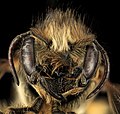Osmia cornifrons
Osmia cornifrons, commonly known as the Japanese horn-faced bee, is a species of mason bee native to Japan. It has been introduced to other countries, including the United States, for the purpose of crop pollination. Osmia cornifrons is a solitary bee, meaning that unlike honeybees or bumblebees, individuals do not live in colonies but rather each female mates, constructs her own nest, and provisions it with pollen and nectar for her offspring.
Description[edit]
Osmia cornifrons is a small bee, with females typically larger than males. The females have a distinctive horn-like projection on their face, which is the origin of their common name. Their body is predominantly metallic blue or green, with dense hairs on the thorax and a series of hair bands on the abdomen. Males are similar in appearance but lack the horn and are generally smaller.
Habitat and Distribution[edit]
Originally from Japan, Osmia cornifrons has been introduced to several other countries, including the United States, primarily for its pollination services in orchards. It prefers temperate climates and is commonly found in habitats that provide suitable nesting sites, such as hollow stems, wood cavities, and specially made nesting blocks.
Life Cycle[edit]
The life cycle of Osmia cornifrons begins in spring when temperatures rise and the bees emerge from their nests. After mating, females search for suitable nesting sites where they lay their eggs. Each egg is laid in a separate cell within the nest, provisioned with a mixture of nectar and pollen. After laying eggs, the female seals the nest, and the adult bees do not survive the winter. The eggs hatch into larvae, which feed on the provisions left by the female, and then pupate to emerge as adults the following spring.
Pollination[edit]
Osmia cornifrons is an effective pollinator of several crops, notably fruit trees such as apples, pears, and cherries. Its activity in the early morning, even in cold or overcast weather, makes it particularly valuable for pollination. Unlike honeybees, Osmia cornifrons does not have a hive to return to, so it tends to move directly from flower to flower, resulting in more efficient pollination.
Conservation[edit]
While not currently listed as endangered, the conservation of Osmia cornifrons and other pollinators is crucial for maintaining biodiversity and food security. Habitat loss, pesticide use, and climate change are significant threats to pollinator populations worldwide.
See Also[edit]
Osmia_cornifrons[edit]
-
Osmia cornifrons
-
Osmia cornifrons, female, face, Washington, DC
Ad. Transform your life with W8MD's Budget GLP-1 injections from $75


W8MD offers a medical weight loss program to lose weight in Philadelphia. Our physician-supervised medical weight loss provides:
- Weight loss injections in NYC (generic and brand names):
- Zepbound / Mounjaro, Wegovy / Ozempic, Saxenda
- Most insurances accepted or discounted self-pay rates. We will obtain insurance prior authorizations if needed.
- Generic GLP1 weight loss injections from $75 for the starting dose.
- Also offer prescription weight loss medications including Phentermine, Qsymia, Diethylpropion, Contrave etc.
NYC weight loss doctor appointmentsNYC weight loss doctor appointments
Start your NYC weight loss journey today at our NYC medical weight loss and Philadelphia medical weight loss clinics.
- Call 718-946-5500 to lose weight in NYC or for medical weight loss in Philadelphia 215-676-2334.
- Tags:NYC medical weight loss, Philadelphia lose weight Zepbound NYC, Budget GLP1 weight loss injections, Wegovy Philadelphia, Wegovy NYC, Philadelphia medical weight loss, Brookly weight loss and Wegovy NYC
|
WikiMD's Wellness Encyclopedia |
| Let Food Be Thy Medicine Medicine Thy Food - Hippocrates |
Medical Disclaimer: WikiMD is not a substitute for professional medical advice. The information on WikiMD is provided as an information resource only, may be incorrect, outdated or misleading, and is not to be used or relied on for any diagnostic or treatment purposes. Please consult your health care provider before making any healthcare decisions or for guidance about a specific medical condition. WikiMD expressly disclaims responsibility, and shall have no liability, for any damages, loss, injury, or liability whatsoever suffered as a result of your reliance on the information contained in this site. By visiting this site you agree to the foregoing terms and conditions, which may from time to time be changed or supplemented by WikiMD. If you do not agree to the foregoing terms and conditions, you should not enter or use this site. See full disclaimer.
Credits:Most images are courtesy of Wikimedia commons, and templates, categories Wikipedia, licensed under CC BY SA or similar.
Translate this page: - East Asian
中文,
日本,
한국어,
South Asian
हिन्दी,
தமிழ்,
తెలుగు,
Urdu,
ಕನ್ನಡ,
Southeast Asian
Indonesian,
Vietnamese,
Thai,
မြန်မာဘာသာ,
বাংলা
European
español,
Deutsch,
français,
Greek,
português do Brasil,
polski,
română,
русский,
Nederlands,
norsk,
svenska,
suomi,
Italian
Middle Eastern & African
عربى,
Turkish,
Persian,
Hebrew,
Afrikaans,
isiZulu,
Kiswahili,
Other
Bulgarian,
Hungarian,
Czech,
Swedish,
മലയാളം,
मराठी,
ਪੰਜਾਬੀ,
ગુજરાતી,
Portuguese,
Ukrainian


